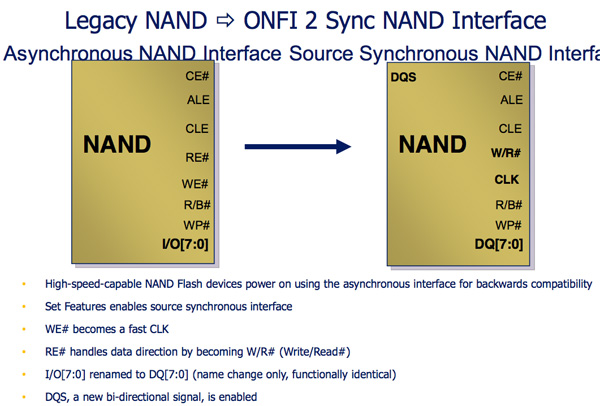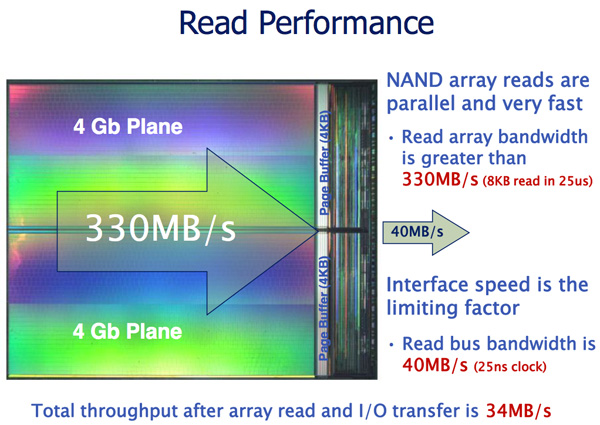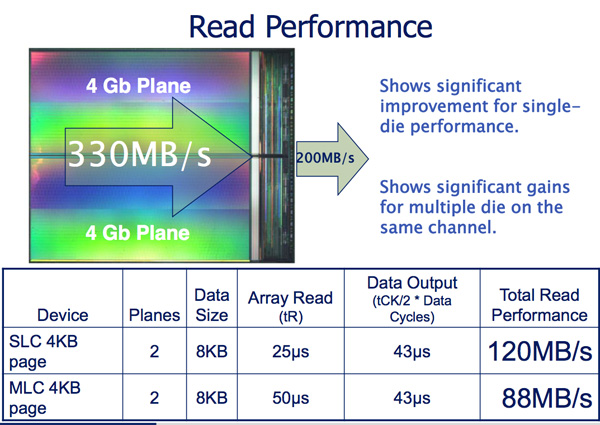SandForce Announces Next-Gen SSDs, SF-2000 Capable of 500MB/s and 60K IOPS
by Anand Lal Shimpi on October 7, 2010 9:30 AM ESTNAND Support: Everything
The SF-2000 controllers are NAND manufacturer agnostic. Both ONFI 2 and toggle interfaces are supported. Let’s talk about what this means.
Legacy NAND is written in a very straight forward manner. A write enable signal is sent to the NAND, once the WE signal is high data can latch to the NAND.
Both ONFI 2 and Toggle NAND add another bit to the NAND interface: the DQS signal. The Write Enable signal is still present but it’s now only used for latching commands and addresses, DQS is used for data transfers. Instead of only transferring data when the DQS signal is high, ONFI2 and Toggle NAND support transferring data on both the rising and falling edges of the DQS signal. This should sound a lot like DDR to you, because it is.

The benefit is tremendous. Whereas the current interface to NAND is limited to 40MB/s per device, ONFI 2 and Toggle increase that to 166MB/s per device.

Micron indicates that a dual plane NAND array can be read from at up to 330MB/s and written to at 33MB/s. By implementing an ONFI 2 and Toggle compliant interface, SandForce immediately gets a huge boost in potential performance. Now it’s just a matter of managing it all.
The controller accommodates the faster NAND interface by supporting more active NAND die concurrently. The SF-2000 controllers can activate twice as many die in parallel compared to the SF-1200/1500. This should result in some pretty hefty performance gains as you’ll soon see. The controller is physically faster and has more internal memory/larger buffers in order to enable the higher expected bandwidths.

Initial designs will be based on 34nm eMLC from Micron and 32nm eMLC from Toshiba. The controller does support 25nm NAND as well, so we’ll see a transition there when the yields are high enough. Note that SandForce, like Intel, will be using enterprise grade MLC instead of SLC for the server market. The demand pretty much requires it and luckily, with a good enough controller and NAND, eMLC looks like it may be able to handle a server workload.










84 Comments
View All Comments
IceDread - Friday, October 8, 2010 - link
Hehe oh yes.Looks like they beat intel's new controller as well, impressive!
Chloiber - Thursday, October 7, 2010 - link
I want to see some benches first before I believe ANYTHING.Same with SF1200. 275MB/s seq. writes on paper but in reality you are down to 100-140MB/s.
Same for the IOPS.
So yeah - unless I see some real benches...
bunnyfubbles - Thursday, October 7, 2010 - link
Agreed, however even if we get real world speed improvements proportional to the best case "on-paper" specs then we're looking at well over 400/MB read and 200MB/sec write real world speeds, which would be amazing for a single drive without resorting to a RAID controller.Intel really seems to be falling by the wayside when we compare these projected specs to what Intel is claiming with their G3 drives, which don't look too threatening to current Sandforce drives let alone this future beast. Hopefully this means some competitive pricing that finally starts to truly drive down SSD prices.
Chloiber - Thursday, October 7, 2010 - link
These specs are controller specs, not SSD specs - remember that.These specs are, what the controller can handle - Flash NOT included. So I would really be impressed if we see those specs on a MLC-based SSD for us consumers.
mino - Thursday, October 7, 2010 - link
Playing the "steady as she goes" song seems a very sensible path for Intel considering the Rock'n'Roll stuff others play.While Intel really wants to be major player LONG-TERM, they need not hurry.
Alas they had their share of mess with buggy FW upgrades not so long ago. I do not see them being overly aggressive anytime soon.
Jaybus - Saturday, October 16, 2010 - link
It isn't all about the controller. Intel will have, at least for a while, a huge lead in price/performance because they are going to 25 nm flash. They will get nearly double the capacity of current 34 nm flash for the same price. Others will also move to 25 nm flash, eventually, but meanwhile, Intel will have an advantage. Also, Intel's controllers have proven to be really good in the real world, and the new one is expected to be on par with SF-1200.I'm sure SF-2000 will be the better performer, but if I a 300 GB Intel drive is the same price as a 160 GB SF-2000 drive, then the SF-2000 drive better be twice as fast. It remains to be seen, but if the SF-2000 isn't WAY, WAY faster, then I'll take twice the capacity for the same price any day.
mailman65er - Thursday, October 7, 2010 - link
So yeah - unless I see some real benches...Totally agreed. And the more "application-specific" the benchmark is, the better. There is so much data 'manipulation' going on inside these modern SSD controllers that you almost need to run "your own" workloads to gauge actual performance.
Guspaz - Thursday, October 7, 2010 - link
Intel's revealed specs on the G3's performance were so underwhelming that it wouldn't take much to destroy them when it comes to performance. SandForce's previous generation parts are already faster than the G3 on paper in terms of sequential transfer rates. Even if they don't surpass that in practice, they're not that far off, so it wouldn't take much of a performance increase from SandForce's next-gen parts to surpass that.rundll - Thursday, October 7, 2010 - link
Intel's 3G's SSDs overall performance should be way over SandForce's actual generations SSDs simply thanks to superior IOPS (read/write 50000/40000).Now, if Intel's 25nm production technology produces significantly cheaper SSDs, could Intel's SSD remain somewhat competitive choice in every day desktop use with its pretty decent speed. Especially if SandForce is putting a hefty pricetag to its new controller.
We'll see.
jonup - Thursday, October 7, 2010 - link
Keep in mind that Intel sells a complete drives not just the controller. They can affort to make their profits not only from the controller but from the entire product. Other SSD manufacturer pay the profit margin of the controller manufacturer as well as the falsh manufacturer and therefore at the end of the day the cost of their final product is highe than Intel's. Intel can affort to sale their products at a significantly lower price than its compatitor and still maintain higher profitability than Sandforce (controller manufacturer) and OCZ, Corsair (drive manufacturers).I believe that Intel position its G3 to capture larger market instead of trying to acheave king of the hill performance. If the supply for SSD begins to match the demand prices of SSDs might start shooting down (as we have been promised for a while now) and Intel will be the big winner. As I've said before, Intel's performance is enough for the needs of the mainsteam PC user that is currently using fast HDDs due to the high cost of SSDs.